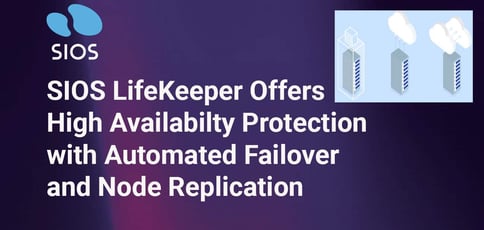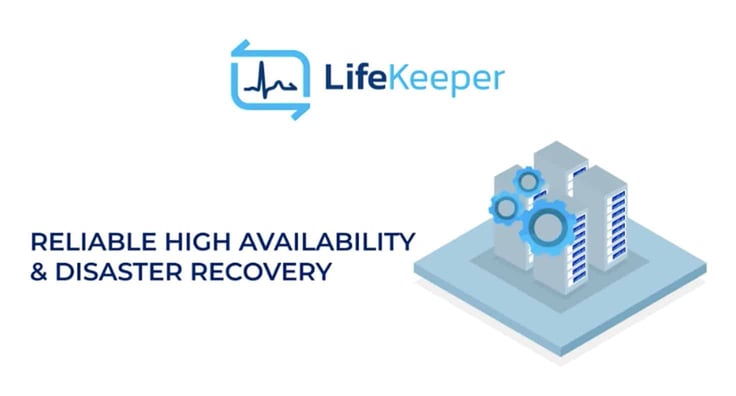
TL; DR: SIOS offers a high availability and disaster recovery platform that automates failover and multitarget node replication. Manual DR testing and failover maintenance can take up valuable time and cause companies to lose revenue because of extended downtime. SIOS solves these pain points by taking the HA process off the IT team’s shoulders and automating configuration and management – whether in the cloud, on-prem, or hybrid environments. Its multitarget replication allows systems to automatically failover to another node within its region or to another geographical location. SIOS also monitors everything within the stack to ensure systems and applications are up and running.
When disaster strikes, it can send a crippling wave through any operation. Disasters are sudden and have detrimental consequences, prompting workers to scramble to catch up. Without contingencies in place, companies can lose a lot of revenue and waste even more time.
“Downtime is extremely expensive. A minute of downtime can cost hundreds of thousands of dollars for organizations. And beyond that is the toll that’s taken on the IT team. The expertise needed to bring a system back online often requires the work of multiple organizations within the IT team,” said Margaret Hoagland, VP of Global Marketing at SIOS.

IT teams are constantly under pressure to deliver on availability and meet service-level agreements for their customers. And if a system goes down, these teams must be ready to recover the system within a guaranteed time frame with all the data intact. Meeting customer demand and satisfaction is paramount to the success of these IT departments. And customers need systems and teams they can count on to power their workloads and infrastructure.
SIOS provides cutting-edge software to help IT teams bolster and deliver application availability for complex applications that run on SAP HANA, SQL Server, Oracle, and other essential systems. The latest release of its LifeKeeper clustering software enables organizations to operate a multitarget high-availability environment for disaster recovery and availability protection. Its LifeKeeper technology dives deep into the entire SAP HANA instance stack to ensure maximum performance.
Providing High Availability Protection on the Cloud and On-Prem
For over 20 years, SIOS has led the disaster recovery and high availability field, developing technologies to ensure availability and eliminate data loss across cloud and on-prem environments. The company has been a Microsoft partner since 2007 and was the first to be certified in high availability for Microsoft Azure. SIOS is also an ISV Accelerate partner for AWS and provides high availability for customers migrating Microsoft workloads into AWS.
The SIOS team has seen many accomplishments, but its LifeKeeper technology remains one of its biggest strengths. LifeKeeper for Linux and LifeKeeper for Windows deliver an automated solution for configuration and management that orchestrates failover for reliable uptime protection. Companies can leverage LifeKeeper for both their cloud and on-prem environments.
SIOS answers a crucial need for SAP HANA customers with LifeKeeper for Linux. The cloud has caused many challenges for companies in high availability protection because it adds complexity, reduces infrastructure control, and makes it challenging to complete realistic DR testing. As a result, IT teams have to engage and struggle with manual tasks to protect their systems. SIOS’s software helps eliminate these pain points with automation.
“It doesn’t require scripting during failover or to restore normal settings. I think people worry that they have to set up these manual systems and can’t test for everything. So there’s always worry in their head that it won’t failover when it’s most needed. And so this product alleviates that worry,” said Margaret.
LifeKeeper runs in the background, monitoring the entire IT stack to ensure everything operates as it should. “We have a plug-in for each different kind of application that provides application-specific intelligence so that our product knows what a given software, such as SAP HANA, requires. It’s using best practices to operate, so the operation continues reliably without a performance hit or an unexpected consequence,” said Margaret.
Simplifying Linux Clustering With Automated Failover and Multitarget Feature
SIOS created LifeKeeper for Linux to simplify Linux clustering and DR and HA protection for customers. Automation plays a massive role in this undertaking, alleviating users of manual tasks and technical barriers. SIOS solves the complexity and unstable pitfalls of other HA solutions and gives companies reliable failover software. Every application has its unique setup and failover requirements, and SIOS’s capabilities address these needs with configured intelligence stacked with vendor best practices.
“Our product helps customers determine whether a process is up and running. If it’s not working, it moves an operation to a standby node and restarts the process in the right order. So the system will failover automatically,” said Masahiro Arai, COO of SIOS.
SIOS clustering software provides high availability, which involves running two or more redundant servers to offset downtime. When application operation on one server fails, the other takes over. But what makes SIOS so unique is that it uses multitarget node replication to facilitate its failover process. SIOS leverages HANA system replication to replicate between multiple nodes synchronously or asynchronously as needed. For example, customers can replicate a database from node A to node B within the same region synchronously but also from Node A to Node C to a second node in a different geographic location asynchronously.

Its multitarget replication can have up to four nodes. Failure on one node allows another node to automatically assume the primary node status and replicate to the DR node. This process usually has a high error rate when done manually, but SIOS allows users to have a reliable failover with its automated system.
Since LifeKeeper monitors more layers of the IT stack for warning signs, SIOS can ensure companies receive a comprehensive overview and solution to their DR and HA needs. SIOS checks everything from the hardware and storage disks to networks and operating systems. When the failover happens, LifeKeeper also looks over the status of the HANA database to ensure the application can continue operating with acceptable data.
“So when HANA goes down, everybody’s wondering how to bring it back up, and while manually scripting the steps to make their secondary node retain DR protection. That’s a huge amount of stress and likelihood of human error. And so we’ve taken all that off ITs’ shoulders. In addition, when you fix the primary node and want everything to normal status, we also automate that process,” said Margaret.
Delivering Peace of Mind With More Features on the Way
LifeKeeper offers users peace of mind with its simple and automated nature. Margaret told us it provides out-of-box stability and tuning, installs in less than an hour, and is five times faster than clustering solutions from open-source OS vendors. LifeKeeper also reduces maintenance and failover testing by up to three days. With all this within the SIOS solution, the HA and DR software company still has more innovation on the way.
“Our next phase of development is all around our usability and our GUI, how you interact with our product,” said Margaret.
Companies using the cloud are demanding ease of use and cloud-friendly solutions, so SIOS prioritizing usability and user-friendliness to help deliver that. The team has more improvement for its clustering technology on the road map as well. Most SIOS customers have numerous clusters to monitor and ensure they are up and running. SIOS will offer the capability to view and manage all those various clusters on a single screen.
The SIOS team also plans to go deeper with its cloud integration to detect early warning signs of failovers, avoid failure when possible, and provide more information about the root causes of failures.
“The next phase will focus on providing customers with more detailed information using that deeper cloud integration so that they don’t just get information that an error happened, but why it happened, and what steps they can take to rectify it,” said Margaret.



